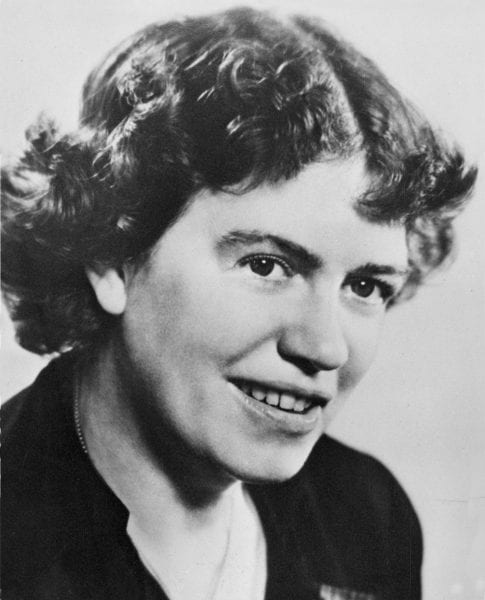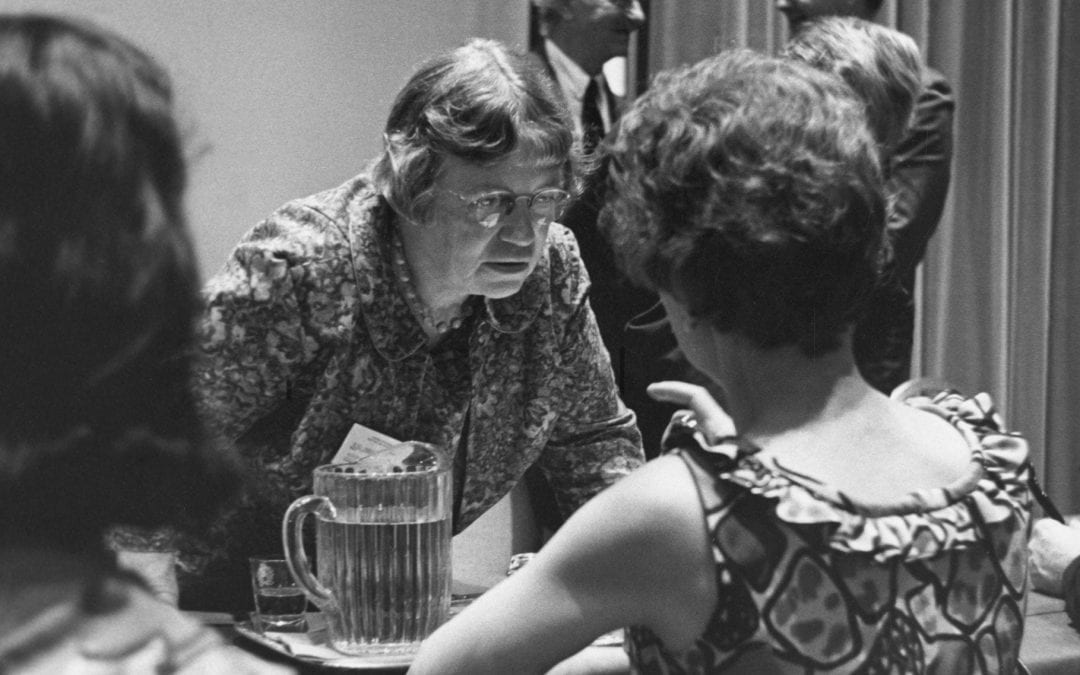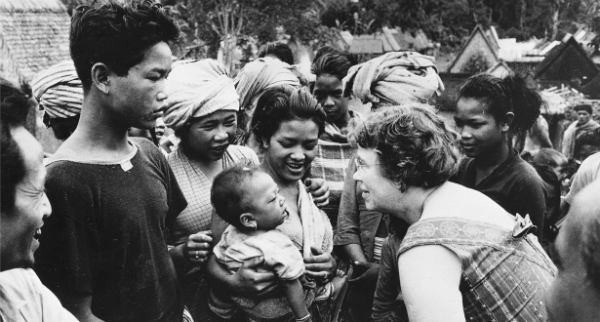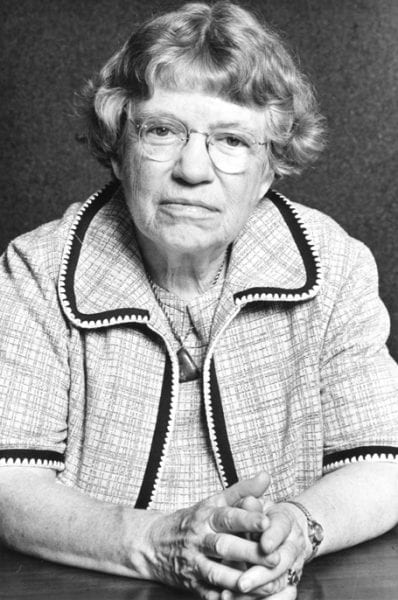By Rachel Davis Van-Voorhis ~
Born in 1901 as an only child of a professor and a sociologist, Margaret Mead was an American cultural anthropologist, one of the second generation of women in the United States to be able to seriously approach sociological questions in an academic setting. While women and minorities were beginning to hold scattered academic positions in the United States in the nineteenth century, sociology and anthropology had not yet become distinct and expected fields, much less the sub-field of cultural anthropology. Mead’s upbringing and social perspective allowed her a freedom and clarity in her career that was unavailable to earlier women in social research fields who rose to what small prominence they were allowed in the decades before Mead’s birth. After getting her undergraduate degree at Barnard, she went on to study anthropology at Columbia University, earning an M.A. and a Ph.D. While at Columbia, Mead was strongly mentored by, and later worked alongside, both Franz Boas, a professor of anthropology who pioneered the concept of cultural relativism, and Ruth Benedict, an student of Boas’s and a professor and anthropologist in her own right, who went on to have a romantic relationship with Mead. Mead held many positions over her lifetime including multiple professorships, a position as a curator and ethnologist at the American Museum of Natural History, and multiple positions on academic boards, but her main focus was always her research, its publication, and its dissemination. Much of her popularity and intellectual longevity was and is due to her role as a public figure, through her many lectures and over twenty books, as well as the forcefulness of her character and the boldness of many of her claims.[1]
Mead’s main academic focuses included child rearing, human personalities, and culture, both in its origins and its implications. Her interests spanned topics as far as environmental degradation, world hunger, women’s rights in the modern world, and nuclear proliferation, but the majority of her work, and her most memorable work, tended to focus on gender and culture, especially through the lens of childhood development.

Margaret Mead in 1948. Source: Acc. 90-105 – Science Service, Records, 1920s-1970s, Smithsonian Institution Archives.
Although she was well received and successful in many senses, she was also a very controversial figure. Much of the controversy early on was focused on the validity of her data collection and interviews, which is typified by the Mead-Freeman controversy, which I will discuss below. An additional source of controversy, especially in more recent years, is the impact on her conclusions that her beliefs surrounding race, determinism, and hierarchy had on her inquiries and conclusions. While Mead collected data from a variety of sources and groups over the course of her career, much of her study focused on the peoples of Oceana. The work that first pushed her into the public eye in 1928, Coming of Age in Samoa, was based on research done with and amongst the Samoan people, specifically the Ta’ū island, for her dissertation.[2]
Mead chose to work with groups she deemed to be primitive peoples for a variety of reasons. The notion of primitive cultures was a popular one at the time, and was used alike by both those who believed in a chronological development of culture, and the connected notion of white supremacy, as well as the apparently more progressive cultural relativists. The descriptor of primitive was used to reference the difference in technological, artistic, and economic achievement as measured against (usually) the United States or Great Britain.[3] That these people were removed enough from the United States of the early twentieth century to differ in superficial customs such as those associated with age, gender, and education, is undeniable, and this distance was helpful in Mead’s search for the line between the innately human and the socially constructed aspects of human communities and cultural norms. However, the notion that non-western cultures, especially those living in less technologically developed regions or in tribal groups rather than cities, were inherently backwards was also a significant factor in her methodological choice, as it suggested a simpler society, and one that was therefore easier to understand and examine in a short time.[4] This perspective of white racial superiority is, I believe, the most problematic remaining aspect of Mead’s work, as other points of academic controversy have largely well-developed schools of thought, even if they remain unresolved.
The most significant discovery that Mead made in her studies of sexuality in Samoa, and rediscovered and emphasized in other cultural areas throughout the rest of her career, was that the cultural and interpersonal influences on the young child shape their beliefs and behaviors as adults, more than genetic or biological disposition does. Colloquially, this is referred to as the nature versus nurture debate, in which Mead falls strongly in the camp of nurture, being a strong proponent of the theory that children learn by observing adult behavior and imprinting their patterns of behavior generally, as well as more specific linguistic, hierarchical, moral, and aesthetic concepts. In Coming of Age in Samoa, the primary difference that Mead identified as significant between Samoan young people and American ones, was their attitudes towards sexuality. Mead describes Samoan culture as having fewer or no issues of shame and embarrassment with sexuality compared to the United States, resulting in an inherently more promiscuous culture.
Mead discusses the perception of pre- and post-pubescent girls in the chapter on “Our Educational Problems in the Light of Samoan Contrasts,” asking, “What is there in Samoa that is absent in America, what is there in America that is absent in Samoa, which will account for this difference?”[5] This lack of a strong line between the child and the adolescent resulted in the absence of a distinction between a group in which sexual notions are inappropriate and a group in which they are appropriate. The resulting lack of sexual shame also meant that the Samoan people had none, or at least very few, of the problematic associations with emerging sexuality in the United States, ranging from the double standard between male and female sexuality to the evolving concept of what constituted a religious obligation.[6]
While Mead used this study to draw conclusions about the negative realities in the United States, it is important to notice that her stance both begins with a sense of Samoan primitivism, as discussed above, and concludes with a vision of a people relatively detached from decision making, less focused on individualism, and observing a relaxed relationship with sexual mores. Mead does not directly condemn these characteristics, but in her passivity, she appears to hold a position which carries a notable weight of unscientific prejudice against the traits that oppose those with which she finds issue in the United States. Disagreeing or disapproving of both extremes is not a fundamental flaw, but her analysis used against American values is well thought out and argued, while the undercurrent of disapproval towards some Samoan behaviors is significant less discussed. This may seem surprising for a social scientist who spent her career focusing so closely on data collection, but perhaps not so surprising for a white researcher in the early twentieth century, especially one influenced so strongly by Franz Boas. Boas, often referred to as the father of modern anthropology, presented a theory of cultural relativism that was groundbreaking at the time, but he also relied on notions primitiveness that seem at odds with much of his work. However it is that he managed to overcome the cognitive dissonance in his work, it apparently worked for Mead as well, as she continued her research in the aforementioned primitive tribes.
The Mead-Freeman controversy, mentioned above, is the name for the discussion and disagreement sparked by anthropologist Derek Freeman’s 1983 publication of Margaret Mead and Samoa: The Unmaking of an Anthropological Myth, ostensibly focused on the inconsistencies within Mead’s 1928 work. While some of Freeman’s arguments, such as the idea that Mead made the Samoan people seem overly simple do hold up, the idea that one of the young women she interviewed lied to her about practices as a joke, and therefore entirely redirected the scope of Mead’s conclusions is entirely flimsy. While Mead’s work was not bulletproof, Freeman’s own work, on a different Samoan island, lead him to very different conclusions, about an agressive and violent culture that seemed incommensurate with Mead’s findings meant he likely had a personal stake in this refutation as well as an academic one. Since Mead’s work and data collection was and is publicly available, both in an appendix in Coming of Age in Samoa, and in full in the Library of Congress archives, it can be relatively easily concluded, that while her style was largely observational, she was very thorough in her data collection, and it seems highly unlikely that her conclusions are vastly incorrect.[7]
While it is almost impossible to remove the racist undertones and logic from her work entirely, but Mead’s discoveries about the transition from childhood to sexual adulthood in human beings are still incredibly insightful. She argued that accepted ideas of femininity and masculinity in Europe and North America were more reminiscent of Victorian values than of those found in Samoa. The problem, according to Mead, is that these values had significant negative effects on the progression of society as well as the development of individuals. Her basic argument was that it was easier to transition to being a sexual adult in Samoa than in the United States because children in Samoa were exposed to the notion of sexuality well before adulthood, while it remained foreign to American children until marriage or just before. This exposure set up Samoan children for a smooth transition to adulthood, as the successful progression of adult, sexual relationships that they had witnessed in their elders was well imprinted, and barring outside interference, there was no reason for them to believe their lives would differ significantly from this pattern. In stark juxtaposition, American children, observing no expression of sexuality and their elders, or at least no healthy and informative expressions, were fundamentally unprepared to live life as sexual adults. This sort of discomfort quickly leads to shame and to self perpetuation of silence about sexuality down the generations, even to the point that sexual shame can be considered innate, and even virtuous.
Much of Mead’s subsequent research bolstered her initial theories, and solidified her as a significant academic voice. By the 1960s and 70s Mead was well-known in her field, and even outside of it in popular American discourse, as in addition to her academic success, she also spoke out regarding current events. Many of her ideas were controversial, but most of them endured, and her effect on the field of cultural anthropology and social science as a whole should not be underestimated, as she, along with Boas, essentially founded the field, developed observational methodologies from classic sociological strategies, and brought it into the public view. She worked up until her death in 1978, and her ideas on the development of sexuality helped to lay the groundwork for the sexual revolution,[8] and many of the terms and concepts that she pioneered or championed exist in the American vernacular to a surprising extent. Margaret Mead faced many challenges along her academic path, but the one that I find to be most compelling is one that received relatively little criticism during her life: that of her assumptions about primitivity and civilization and the racial and cultural inequities even within cultural relativism.
About the author:
Rachel Davies-Van Voorhis is a third-year Religious Studies major at the University of Chicago, also pursuing a minor in the History, Philosophy, and Social Science of Medicine. Her interest in the sociology and anthropology began in high school and has developed through her study of comparative religion, leading her to Parysa Mostajir’s course on the History of the Social Sciences. Rachel is interested in the psychological effects of culture and religion, and her study of Margaret Mead has only heightened this interest. Rachel is an avid reader and apple pie connoisseur.
References:
Featured Image: Margaret Mead speaking to journalists at the New York Academy of Sciences in 1968. Source: Acc. 90-105 – Science Service, Records, 1920s-1970s, Smithsonian Institution Archives
[1] The Editors of the Encyclopedia Brittanica, “Margaret Mead,” in The Encyclopedia Brittanica. (Updated November 11, 2020) https://www.britannica.com/biography/Margaret-Mead.
[2] Margaret Mead, Coming of Age in Samoa: A Psychological Study of Primitive Youth for Western Civilisation. (New York: William Morrow and Company, 1928) https://archive.org/details/comingofageinsam00mead/page/n5/mode/2up.
[3] Elman R. Service, “Primitive Culture,” in The Encyclopedia Brittanica. (2018) https://www.britannica.com/topic/primitive-culture.
[4] Margaret Mead, Coming of Age in Samoa, 7.
[5] Margaret Mead, Coming of Age in Samoa, 198.
[6] Margaret Mead, Coming of Age in Samoa, 200.
[7] Ivan Brady, “The Samoa Reader: Last Word or Lost Horizon?”, in Current Anthropology, Volume 32, Issue 4. (Chicago: diversity of Chicago Press, 1991) 497-500. http://www.oswego.edu/~brady/library%20items/samoa.pdf.
[8] Clay Evans, “Both Sides Misunderstand Margaret Mead,” in the Colorado Arts and Sciences Magazine. (Boulder, 2017) https://www.colorado.edu/asmagazine/2017/12/01/both-sides-misunderstand-margaret-mead-prof-contends.



